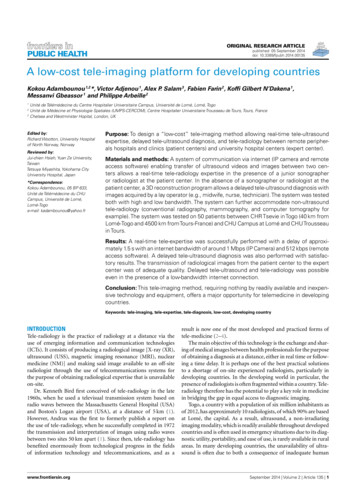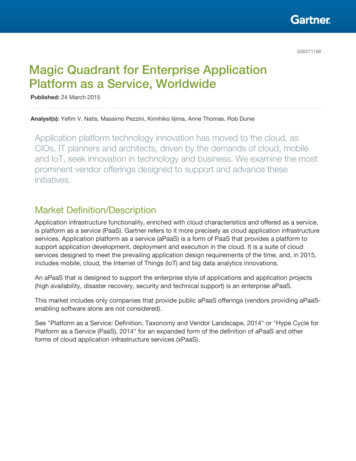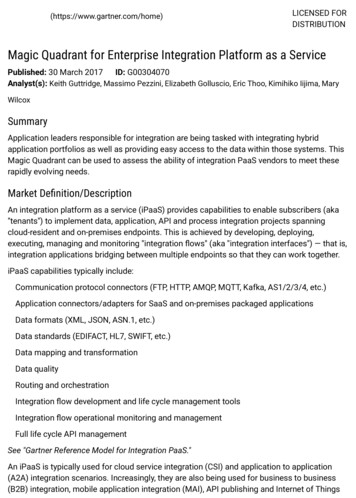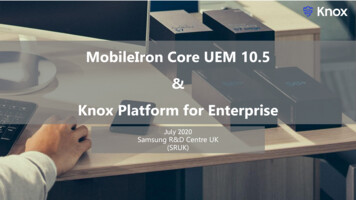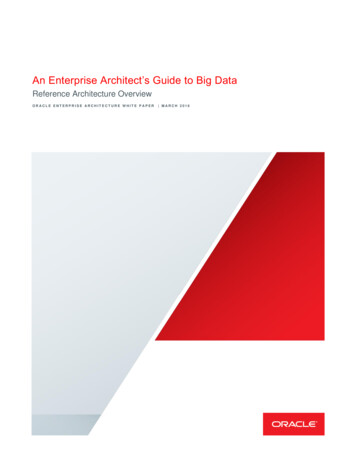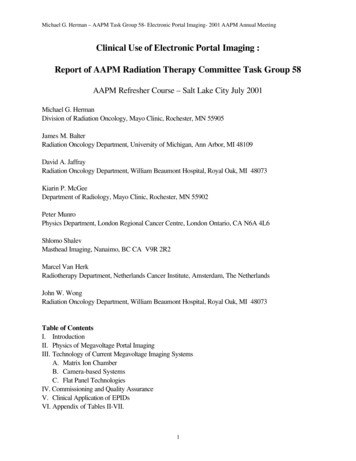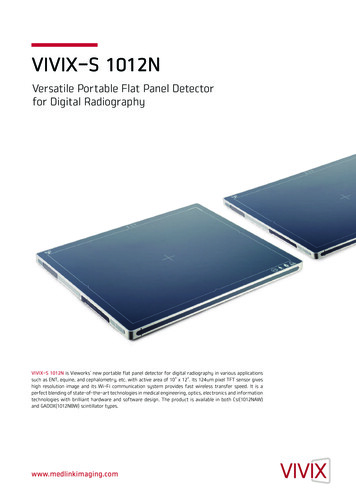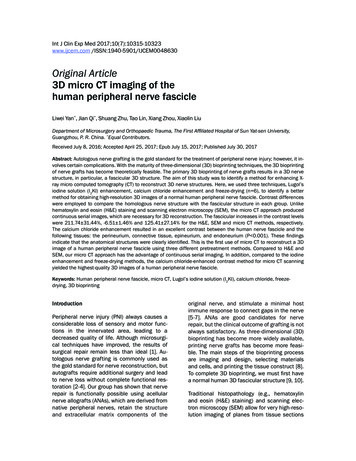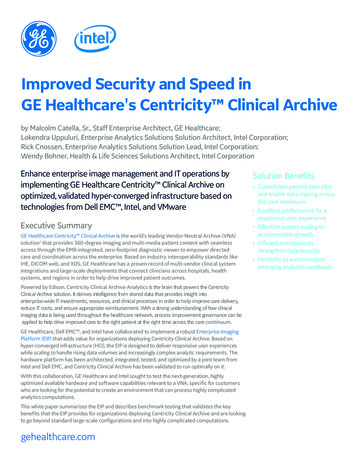
Transcription
Improved Security and Speed inGE Healthcare's Centricity Clinical Archiveby Malcolm Catella, Sr., Staff Enterprise Architect, GE Healthcare;Lokendra Uppuluri, Enterprise Analytics Solutions Solution Architect, Intel Corporation;Rick Cnossen, Enterprise Analytics Solutions Solution Lead, Intel Corporation;Wendy Bohner, Health & Life Sciences Solutions Architect, Intel CorporationEnhance enterprise image management and IT operations byimplementing GE Healthcare Centricity Clinical Archive onoptimized, validated hyper-converged infrastructure based ontechnologies from Dell EMC , Intel, and VMwareExecutive SummaryGE Healthcare Centricity Clinical Archive is the world's leading Vendor-Neutral Archive (VNA)solution1 that provides 360-degree imaging and multi-media patient content with seamlessaccess through the EMR-integrated, zero-footprint diagnostic viewer to empower directedcare and coordination across the enterprise. Based on industry interoperability standards likeIHE, DICOM web, and XDS, GE Healthcare has a proven record of multi-vendor clinical systemintegrations and large-scale deployments that connect clinicians across hospitals, healthsystems, and regions in order to help drive improved patient outcomes.Powered by Edison, Centricity Clinical Archive Analytics is the brain that powers the CentricityClinical Archive solution. It derives intelligence from stored data that provides insight intoenterprise-wide IT investments, resources, and clinical processes in order to help improve care delivery,reduce IT costs, and ensure appropriate reimbursement. With a strong understanding of how clinicalimaging data is being used throughout the healthcare network, process improvement governance can beapplied to help drive improved care to the right patient at the right time across the care continuum.GE Healthcare, Dell EMC , and Intel have collaborated to implement a robust Enterprise ImagingPlatform (EIP) that adds value for organizations deploying Centricity Clinical Archive. Based onhyper-converged infrastructure (HCI), the EIP is designed to deliver responsive user experienceswhile scaling to handle rising data volumes and increasingly complex analytic requirements. Thehardware platform has been architected, integrated, tested, and optimized by a joint team fromIntel and Dell EMC, and Centricity Clinical Archive has been validated to run optimally on it.With this collaboration, GE Healthcare and Intel sought to test the next-generation, highlyoptimized available hardware and software capabilities relevant to a VNA, specific for customerswho are looking for the potential to create an environment that can process highly complicatedanalytics computations.This white paper summarizes the EIP and describes benchmark testing that validates the keybenefits that the EIP provides for organizations deploying Centricity Clinical Archive and are lookingto go beyond standard large-scale configurations and into highly complicated computations.gehealthcare.comSolution Benefits Consolidate patient data silosand enable data sharing acrossthe care continuum Excellent performance for aresponsive user experience Effective system scaling toaccommodate growth Efficient encryption tostrengthen data security Flexibility to accommodateemerging analytics workloads
GE Healthcare Centricity Clinical Archive:Enterprise Imaging Platform:Seamless Connectivity to Help Improve Care High Performance and EfficiencyCentricity Clinical Archive is an open-architecture VNA solutionfor Centricity Clinical Archivethat unifies and intelligently manages patient data, images, andenterprise content. Built on industry standards, Centricity ClinicalArchive enables seamless connectivity among disparate systemsacross multiple archive systems, specialties, and facilities.Unlike VNAs that only consolidate departmental DICOM files,Centricity Clinical Archive provides full support for a widerange of interoperability standards. These include HL7 as wellas Integrating the Healthcare Enterprise’s Cross-EnterpriseDocument Sharing (IHE-XDS) format and the Enterprise Master/Patient Index (EMPI). Centricity Clinical Archive further overcomesthe limitations and inconsistencies of multi-vendor picturearchiving and communications systems (PACS) by providingadvanced tag morphing and image lifecycle managementcapabilities that optimize image sharing and workflows acrossdiverse systems and technologies.This broad support helps health systems securely share andinteract with virtually any enterprise or community archive. It alsohelps clinicians streamline enterprise-level and community-widecollaboration to improve clinical decision making and treatmentplanning and deliver efficient, coordinated care.Figure 1 summarizes Centricity Clinical Archive and showscapabilities, standards, and interfaces.The EIP leverages HCI, combining compute, storage, networking,and virtualization software resources to deliver a scalable modernenterprise platform. As a preconfigured and validated solution,the EIP takes the guesswork out of infrastructure choice anddeployment, helping health systems speed time-to-value, simplifyIT operations, save data center space, and reduce total cost ofownership (TCO).With a future-facing design and the latest technologies fromIntel and Dell EMC, the EIP delivers outstanding performance forCentricity Clinical Archive. Health systems can take full advantageof Centricity Clinical Archive’s rich feature set while also gaining theflexibility to manage data growth and accommodate innovationssuch as powerful new artificial intelligence (AI) algorithms.Organizations also gain capabilities to help make patient informationmore accessible and secure with available cloud-connected disasterrecovery and virtual server deployment options, along withstandardized configurations that help improve reliability.EIP REMOVES THE GUESSWORKEnterprise Imaging Platform takes the guessworkout of infrastructure choice and deployment,helping health systems speed time-to-value,simplify IT operations, save data center space,and reduce total cost of ownership (TCO).Patient DemographicSourcesGE Healthcare Centricity Clinical ArchiveConsumersof InformationHospitalInformation SystemZero Footprint ViewerRadiologyInformation SystemElectronic MedicalRecordsEnterprise Master/Patient IndexIHE-XDS RegistryNon-DICOMDICOMAdd-OnsUser ManagementDevice IntegrationClinical GatewayLDAPElectronic MedicalRecordsElectronic MedicalRecords/DepartmentAudit Trail andNode AuthenticationPatient Clinical Data SourcesScanners and Digital CamerasMessage Sources (HL7)DICOM SourcesNon-DICOM SourcesFigure 1. GE Healthcare Centricity Clinical Archive supports secure information sharing across diverse information systems.2 of 6Improved Security and Speed in the GE Healthcare Centricity Clinical Archive
Figure 2 shows the EIP’s hardware and software components, withCentricity Clinical Archive installed at the top of the solution stack.Tables 1-3 list the hardware and software that comprise the EIP.Validating Platform PerformanceTo validate the EIP/Centricity Clinical Archive system and providepotential users with a realistic idea of its performance, a teamof solution architects and benchmarking experts from Inteldeveloped a benchmarking suite that simulates a real-world,large-hospital environment. The benchmarking team ran a rangeof tests on the EIP described in Tables 1-3. Tests were performedin July 2018 at the Intel test lab in Hillsboro, Oregon.The simulation model incorporated data from the research firmFrost & Sullivan2 showing traits such as average and peak studysizes, procedure volume and mix, file sizes by modality, andimaging volumes for hospitals with 500 or more beds. The modelalso reflected the load on the server from scanners, viewers, andother hospital information systems.GE Healthcare Centricity Clinical ArchiveZero FootprintViewerRegistryArchiveVMware Server VirtualizationSoftware-DefinedStoragevSAN HypervisorESXi ComponentQuantity tworkAdapterStorageControllerBoot Drive4FlashCache DriveFlashCapacity DriveDell EMC PowerEdge C6400 enclosure,2.5” NVMe, Dell EMC PowerEdge C6420vSAN Ready NodeIntel Xeon Gold 5120 processor 2.2GHz, 14C/28T, 10.4 GT/s 2UPI, 19 M Cache,Turbo, HT (105 W) DDR4-240032 GB RDIMM, 2667 MT/s, dual-rank4Intel X710 dual-port 10 GB direct attach,SFP , converged network adapter,low profileIntel X710 dual-port 10 GB, SFP ,OCP mezzanine cardDell PERC H330 RAID controller card464 GB micro SDHC/SDXC card8375 GB Intel Optane SSDDC P4800X Series U.2 NVMe2 TB Intel SSDDC P4510 Series U.2 NVMe16Table 2. Physical Resources SummaryEnterprise Imaging PlatformEMPITable 1. Enterprise Imaging Platform (EIP) Hardware ComponentsManagementServervCenter CategoryRequirementCompute112 coresMemory1536 GBCache Storage3.20 TBCapacity Storage30.72 TBNetwork10 GbpsDeep-Learning Deployment ToolkitIntel Math Kernel LibrarySoftwareVersionVMware vSphere ESXi 6.7VMware vSAN 6.7StorageVMware vCenter 6.7Capacity TierIntel Optane and Intel 3D NAND SSDsIntel Math Kernel Library2018 update 3OpenVINO Deep Learning Deployment Toolkit2018 R2 releasePython*3.6Operating SystemCentos Linux*Cache TierIntel Optane MemoryTable 3. Software ComponentsNetworkIntel Ethernet 10 Gigabit Server AdaptersComputeIntel Xeon Scalable Processors(2U, 4-Node, Dual-Socket Hyper-Converged Infrastructure)Figure 2. Enterprise Imaging Platform (EIP) solution stack with GE HealthcareCentricity Clinical Archive installed.3 of 6Improved Security and Speed in the GE Healthcare Centricity Clinical Archive
Test DescriptionsTests included real-world simulations focused on traits affectinguser responsiveness, as well stress tests and peak-performancetests to determine how well the platform performed under eachworkload. The team used Locust.io, a scalable, open-source loadtesting framework, to simulate the real-world load of CentricityClinical Archive running on the EIP.The real-world scenario, large-hospital test used the team’ssimulation model. Locust simulated uploads (which typically comefrom scanners and others hospital systems) as well as downloads(which are used for viewing by radiologists and transmissionto other hospital systems). Uploads consisted of studiesselected randomly from a pool of curated, open-source medicalimaging data. The pool contained full studies of DICOM imagesfor computed tomography (CT), digital radiography, magneticresonance, mammography, nuclear medicine, ultrasound, andx-ray angiography. Downloads consisted of all requests neededto pull a randomly selected full study load (FSL) from previouslyuploaded studies. Downloads included search requests, studymetadata requests, thumbnail downloads, JPEG downloads, and.RAW data files for a requested study.Stress tests assessed maximum throughput for uploading studiesto the clinical archive and downloading studies for viewing. Inthe maximum upload stress test, Locust repeatedly uploadeda golden CT DICOM study of random patients, which had beenadded to the system before the test. The test gradually increasedthe number of Locust users uploading the study to reach amaximum images/second throughput value.For the maximum download stress test, Locust repeatedlydownloaded a golden CT DICOM study that was uploaded duringan earlier upload test. The test gradually increased the number ofLocust users downloading the study to determine the maximumnumber of images/second throughput value.The team also ran tests with and without encryption enabled toassess the performance impact. This activity reflects the importanceof data security. Full encryption enabled means TLS for all end points,SQL server database, and full disk encryption is enabled.Benchmarking EnvironmentTo characterize system performance for the various testscenarios, the team gathered profiling metrics such as CPU usage(the percentage of CPU resources being used actively across allcores), network usage (the percentage of network bandwidthbeing used), disk usage (the percentage being used for both readand write operations), and memory usage (the amounts used andcached) to characterize system performance for the various testscenarios. The team used open-source software from Zabbix* formonitoring networks, operating systems, applications, and otherIT resources —to observe performance and gather relevant data.Figure 3 provides an overview of the benchmarking environment,and Table 4 lists software elements used in the environment.Table 4. Software Components of Benchmarking EnvironmentComponentPurposeHL7 PackagepynetdicomHandle HL7 message format for registering patients inthe GE Centricity Clinical GatewayHandle DICOM image formatpydicomHandle DICOM image formatLocust.ioSimulate load on the systemZabbix*Monitor and collect metricsBenchmarking EnvironmentLoad-Generation EnvironmentLocustMasterGE Healthcare Centricity Clinical ArchiveLocust SlaveZero Footprint ViewerWebSocketWebSocket APIGE Centricity Clinical GatewayHL7 InterfaceHL7 ClientsEnterprise ArchiveDICOM ClientsMetricsDICOMMaster Patient IndexXDS RegistrySQL ServerZabbix*Figure 3. Technical overview of the benchmarking environment. The benchmark team used Locust.io to simulate the real-world load of the GE HealthcareCentricity Clinical Archive system running on the Enterprise Imaging Platform (EIP) and the Zabbix* monitoring tool to gather profiling metrics.4 of 6Improved Security and Speed in the GE Healthcare Centricity Clinical Archive
Benchmark ResultsMaintaining Clinician Productivity: Average ImageAccess Times in Real-World ScenariosFigure 4 reports the average image access times for the realworld, large-hospital scenario with an upload-to-download ratioof 1:1. The team tested five types of files:1.2.3.4.5.First image load JPEG format (FIL JPEG)Full study load JPEG Format (FSL JPEG)First image load DICOM format (FIL)Full study load DICOM format (FSL)First image upload (FIU)Encrypting patient data at rest and in flight is an effective way tostrengthen data protection, but traditional software-based dataencryption often brings a significant performance penalty. To avoidthis, enterprises often choose to avoid encrypting data.Intel Advanced Encryption Standard New Instructions (Intel AES-NI)applies hardware-aided capabilities that accelerate encryption toolssuch as BitLocker* and help maintain high performance. Performanceimpact becomes evident when EFS encryption is used, which does notsupport AES-NI, instead of BitLocker, which does support it.0.50.570.44FILJPEGFSLJPEGFILFSLFIUAverage Image Upload TimesPer ImageTime mber of UsersFigure 5. The upload stress test showed the average upload times perimage increased less than twofold as the number of users rose tenfold.Average Image Upload TimesWith Encryption Disabled and Enabled0.30.2470.250EncryptionDisabledBitLocker* Encryptionwith Intel AES-NI0.20.10Figure 6. With Intel Advanced Encryption Standard New Instructions(Intel AES-NI) in place, the upload stress test showed only a minimalperformance impact from encryption.Figure 6 shows the average upload time with encryption enabledand disabled during the upload stress test. With Intel AES-NIrunning, the performance impact when encryption is enabledis less than 2 percent, allowing institutions to reinforce datasecurity by running encryption for all operations.5 of 61.0Figure 4. In the simulated real-world hospital of 500 or more beds, theEnterprise Imaging Platform (EIP) loaded a full study in 1.86 seconds,to deliver a responsive experience for busy clinicians.Time (seconds)Strengthening Security: Upload Stress Testwith and without Encryption1.241.07Simulated Real-World WorkloadsScaling to Handle More Users: Upload Stress TestsThe benchmark tests confirmed that the EIP smoothly scalesto handle increasing numbers of simulated Centricity ClinicalArchive users under peak load and stress scenarios withoutsignificant degradation. The upload stress test results in Figure 5show that the average upload time per image less than doubledeven as the number of users rose tenfold. Performance remainedwell within optimal limits, ensuring that the system can scaleto accommodate large numbers of users without significantperformance degradation.1.50The tests showed that Centricity Clinical Archive delivers outstandingperformance on EIP, loading a full study in less than two seconds.This steady performance ensures a responsive experience, enablingclinicians to load and view large imaging studies with little or no lag.GE Centricity Clinical Archive loaded a full study inless than two seconds, enabling clinicians to loadand view large imaging studies with little or no lag.1.862.0Time (seconds)Figures 4-7 show test results for Centricity Clinical Archiverunning on the EIP in real-world scenarios and under stress withfull encryption enabled.Average Image Access TimesImproved Security and Speed in the GE Healthcare Centricity Clinical Archive
Providing Headroom for New Use Cases:Maximum CPU UsageMany Centricity Clinical Archive users are beginning to deployincreasingly sophisticated analytics and AI capabilities to gainvaluable new insights from their growing stores of healthcaredata. EIP has been architected with the system resources neededto handle these and other additional workloads. Figure 7 showsmaximum CPU usage of key Centricity Clinical Archive componentsduring upload and download stress tests. With maximum CPUusage under stress of 40 percent or less, the system has ampleoverhead room to run additional compute-intensive workloads.Stress Test Maximum CPU UtilizationCPU Utilization40%40%36%SummaryThe industry’s #1 VNA1 , Centricity Clinical Archive offers acomprehensive, longitudinal view of patient data from a widevariety of healthcare information systems. By delivering clinicalinsight at the point of care, Centricity Clinical Archive can helpimprove decision making, reduce unnecessary tests, and optimizeTCO. By facilitating collaboration across the healthcare enterpriseand beyond, Centricity Clinical Archive helps organizations meetthe mandate for efficient, coordinated care.The EIP developed by GE Healthcare, Dell EMC, and Intel isarchitected for optimal performance and easy deployment fororganizations implementing Centricity Clinical Archive. Theteamwork among GE Healthcare, Dell EMC, and Intel simplifiesinfrastructure choice and deployment while providing healthcareorganizations with a powerful foundation to improve clinical care,workflows, and costs, as well as achieve important clinical andoperational objectives.30%Find the solution that is right for your organization.Contact your Intel or GE Healthcare representativeor visit intel.com/healthcare and gehealthcare.com.20%10%0%Enterprise ArchiveUploadZero Footprint ViewerDownloadFigure 7. Maximum CPU usage remains well within accepted limits evenunder stress, offering flexibility to support additional workloads.Imagination at workLearn MoreYou may also find the following resources useful: GE Centricity Clinical ArchiveEnterprise Imaging Platform from Dell EMC and IntelDell EMC Hyper-converged InfrastructureIntel Xeon Gold ProcessorsVMware vCenter ServerVMware vSANVMware vSphere ESXiReferences1 IHS, Medical Enterprise Data Storage Market, 2017. ise-imaging/centricity-clinical-archive.2 Frost & Sullivan, Estimates of Hospital Load, December 2017. 2018 General Electric Company. All rights reserved. GE, GE Healthcare, Centricity, and the GE logo are trademarks of General Electric Company. 2018 Dell EMC Corporation. All rights reserved. Dell EMC, the Dell EMC logo, PowerEdge, VMware, the VMware logo, ESXi, vSphere, vCenter, and vSAN are trademarks of Dell EMC Corporation. VMware is an indirectlyheld, majority-owned subsidiary of Dell Technologies. 2018 Intel Corporation, All rights reserved. Intel, the Intel logo, Xeon, Optane, and OpenVINO
2 of 6 Improved Security and Speed in the GE Healthcare Centricity Clinical Archive GE Healthcare Centricity Clinical Archive: Seamless Connectivity to Help Improve Care Centricity Clinical Archive is an open-architecture VNA solution that unifies and intelligen
